I was introduced to Tuba Skinny in 2010 through videos uploaded by YouTube pioneers Al and Judy Alexander. The Alexanders, whose YouTube channel is digitalalexa, frequently traveled to New Orleans from their home in New Jersey and filmed the band with high-quality equipment. Randy Cassaly, who lives in Louisiana, also posted some early videos. He publishes his videos as RaoulDuke504.
There are now numerous video-makers capturing and uploading hundreds of performances, especially from festivals. As a result, performances by Tuba Skinny have been watched millions of times by people all round the world—most of whom have never seen the band in the flesh.
Tuba Who?
So who are Tuba Skinny? They are a group of young musicians who migrated to New Orleans after Hurricane Katrina and met while busking on the streets. New Orleans has been their base ever since. That is where they spend the temperate months. But during the heat of summer they tour in the northern states and abroad. They have played in Spain, Italy, Sweden, Switzerland, Mexico, and Australia. This year they toured extensively in Belgium, France and in Holland, where they participated for several weeks in a new venture, working in an entertainment complex that included a circus.
How did the band get its name? There was a magnificent, bulky tuba player, Anthony Lacen, known as Tuba Fats, who used to perform in New Orleans. He died in 2004 at the age of 53. So when Todd Burdick from Chicago —a tall, slender gentleman—appeared in 2008 playing a tuba in the French Quarter, he inevitably became Tuba Skinny. Fellow buskers formed a band around him: Tuba Skinny and His Tiny Men. This was soon abbreviated to Tuba Skinny. Todd, by the way, arrived in the city as a banjo-player but had very rapidly mastered the tuba. Most of the young musicians in New Orleans play at least two instruments.
Loose Marbles
After Katrina, the traditional jazz group leading the Renaissance in New Orleans was The Loose Marbles, founded by clarinet player Michael Magro. He gave opportunities to countless musicians. Many of them, honing their skills in Loose Marbles, went on to form their own bands. That was what happened with the founders of Tuba Skinny.
They started with just five instrumentalists (Todd, Shaye Cohn, Barnabus Jones, and two who later left) plus a superb singer—Erika Lewis from New York State’s Hudson Valley. She has a soulful plaintive voice and great intonation. Her phrasing is perfect and she skillfully uses rubato. Since 2012, Erika has also taken to playing the bass drum, further solidifying the band’s rhythm section.
There was no reed player, so the band had a distinctively brassy sound. They rapidly recruited Robin Rapuzzi on percussion, but it wasn’t until the release of their fourth album Rag Band in 2012 that their sound was enriched by clarinet and saxophone players (Texan Jon Doyle and Ewan Bleach from England—both outstanding but with bands of their own to run elsewhere). As Tuba Skinny evolved, several such fine musicians had spells with them and then moved on to other things.
Line up and Albums
Fast-forward to today and Tuba Skinny have a settled line-up, still with the nucleus of Todd, Shaye, Barnabus, Robin, and Erika but also with Craig Flory from Seattle (reeds), Jason Lawrence (six-string banjo), Max Bien-Kahn from Oregon (resonator guitar) and Greg Sherman (resonator guitar and vocals).
Over the years, the band has released nine albums containing a total of 129 tracks. My favourite album is Pyramid Strut, recorded in Tasmania when they were on tour in 2013. Westen Borghesi (tenor banjo) and Jon Doyle (reeds) were in the seven-piece band on that occasion.
Playing the Street
Despite their ability to draw crowds at international festivals, Tuba Skinny have never lost their love of regularly busking in front of a couple of dozen people—particularly in Royal Street, their spiritual home in the French Quarter of New Orleans. It is the ideal place for them to work on tunes and for fans to hear them. The atmosphere is intimate and the acoustics excellent. The clear tones of every instrument are unspoiled by electronic amplification.
What makes them so Special?
They challenge conventions and show the rest of us how best to present our music. Let me give you examples. Wherever possible, they play seated in an arc formation. Sitting makes for relaxation. The arc enables the audience to see all members of the band. And the musicians can see each other, which is good for communication. The unofficial musical director, Shaye, gives discreet signals with hand, foot or a mere glance. Many other bands could benefit from adopting such a formation.
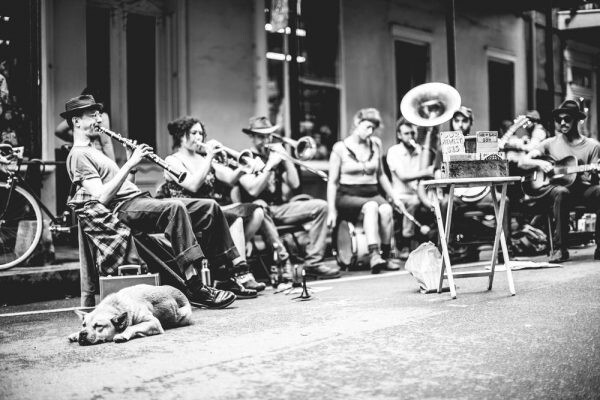
The band’s teamwork is exemplary. They prefer collective improvisation to prima donna solos. Most bands spin out tunes to seven or eight minutes with a dreary succession of solo choruses. But Tuba Skinny are concise: usually, in a 32-bar chorus, two or more instruments take the lead in turn, or “trade fours,” with others providing decorative backing rather than taking a rest; and thus a performance full of interest is completed in three or four minutes.
They have built up a huge repertoire, mixing classics (especially rags and blues) with modern material. I have counted 327 different tunes played in videos and there are doubtless more. This summer, even while touring in Europe, they were still introducing long-forgotten tunes. How different from the tired-sounding bands who play the same handful of pieces week after week!
Artists whose music they have revived include Lucille Bogan, Victoria Spivey, Memphis Minnie, Jabbo Smith, Georgia White, Merline Johnson, Hattie Hart, The Memphis Jug Band, Blind Blake, Clara Smith, The Dixieland Jug Blowers, and The Mississippi Mud Steppers. They have rescued from near-obscurity such gems as “Muddy Water,” “Russian Rag,” “Chocolate Avenue,” “Frog Hop,” “Variety Stomp,” “Dear Almanzoer,” “Harlem’s Araby,” and “Minor Drag.” They have shown how exciting these tunes can be.
They work hard researching archaic material and devising ways of playing it with fresh vigor. And they are perfectionists. Look, for example, at their performances of “Deep Henderson,” a tricky multi-part rhythmic piece.
While showing respect for the 1926 recording by King Oliver’s Band, Tuba Skinny does not slavishly imitate. They have arranged the piece meticulously. They know exactly who will do what, and when. Now watch other bands playing this tune. Almost invariably they depend on printed arrangements, and their performances sound stilted.
Tuba Skinny are adventurous in their preparations. They devise neat introductions and codas. They frequently incorporate key changes or play in uncommon keys. They use an amazing variety of rhythmic patterns in support of those taking the lead. They are slick in their exploitation of two-bar breaks (considered by Jelly Roll Morton an essential ingredient of jazz). They observe dynamics—the “light and shade” of the music. They internalize all these niceties, so there is no need for printed music.
They respect each other’s rôle and importance, so everyone can be heard. Individual instruments are not drowned out, as happens with some bands.
They take trouble setting the tempo and maintain it with metronomic accuracy. Tunes are played against a rock-steady rhythm, with tuba, washboard, guitar, and banjo laying down the foundation while the cornet, trombone, and clarinet frolic around the melody. The combination of Todd Burdick on tuba and a guitar player such as Max Bien-Kahn provides a powerful engine that drives the band along; and all the string players over the years have been brilliant at supporting the rhythms and playing melodic passages when required.
The band does not stick doggedly to a formula. Their music contains Caribbean, bluegrass, and rhythm and blues influences. And they don’t mind including a waltz in their program—played lovingly, allowing the melody to speak for itself.
Originals
Members of the band have themselves composed at least fifteen pieces that are now in their repertoire. Most notable has been Shaye Cohn. Her elegiac “Deep Bayou Moan” is a beautiful, wistful tune, rich in minor chords. “Blue Chime Stomp” is clever and entertaining. “Owl Call Blues” (composed jointly with Erika) is a haunting song. “Salamanca Blues,” a melancholy piece with themes in F and then Ab, gives plenty of opportunities to the trombone and banjo. “Nigel’s Dream” sounds so authentically 1920s that you could be fooled into thinking it was an undiscovered manuscript of King Oliver’s. There is the Mortonesque “Pyramid Strut”—the most complex of Shaye’s creations, with four themes, as well as an 8-bar bridge, and using two keys. Lots of “breaks” are built in and there is a witty coda.
A Model Collective
Tuba Skinny are a model collective enterprise, all virtuosos but with no show-offs: they all put the overall sound of the band before personal glory. But I must admit a special admiration of Shaye Cohn, the young lady who plays the cornet and directs the musical traffic. She arrived in New Orleans from New York as a classically-trained pianist who was also a fine violinist and accordion-player. In Loose Marbles she played the piano but then got hold of an old cornet (which she still plays), taught herself the fingering, and became second trumpet to Ben Polcer. It was an experience from which she learned much and fast.
Shaye is not a showy player who pointlessly produces lots of high and raucous notes, like so many traditional jazz band trumpeters. Skillfully using mutes, she has a unique tone that encapsulates the blues feeling at the heart of our music: she has a great instinct for bluesy notes in the right places. Her phrasing is impeccable. Her playing is energetic and busy, but in an unobtrusive way. Listen to her subtle improvisations and don’t miss her delicate arabesques behind the solos of others.
Barnabus Jones, who arrived in New Orleans from Virginia as a banjo-player and violinist, rapidly mastered the trombone and soon sounded like the great trombonists who played with Armstrong in the 1920s. He has developed a tone that perfectly matches Shaye’s. It gives a sense of power under control, with the slight raspiness so valuable in traditional jazz. He produces musical phrases that perfectly complement her melodic inventions.
Tuba Skinny are surprisingly modest, unassuming people, having fun playing the music they love and scarcely aware of their own enormous talent. They present themselves in a laid-back, smart-casual manner. The gents wear baseball caps and—on hot days—play in singlets and shorts. The ladies have a penchant for short socks and flat shoes or trainers. So they have perfect looks for a New Orleans street band; and they tend to dress similarly for indoor gigs—bringing fresh air into what might otherwise be stuffily formal venues.
To see and hear them for yourself, go to YouTube, type “Tuba Skinny” into the search box and you will be able to choose from hundreds of videos. If you would like an immediate example of the energy and creativity with which they have been playing in 2018, listen to this performance of “Shake It and Break It”. And at tubaskinny.bandcamp.com, you can sample all their albums and place orders if you wish.
To an old man such as myself, it is thrilling that there are such young people in New Orleans, keeping alive the traditional jazz of that great city.
Related:
Tuba Skinny’s 2019 album Some Kind-a-Shake
Tuba Skinny, Stars of the New Orleans Renaissance: Three Albums Reviewed
Shaye Cohn Discography
Robin Rapuzzi Discography
Traditional Jazz with Pops Coffee- His Three Books Reviewed
Pops Coffee Retires His Blog
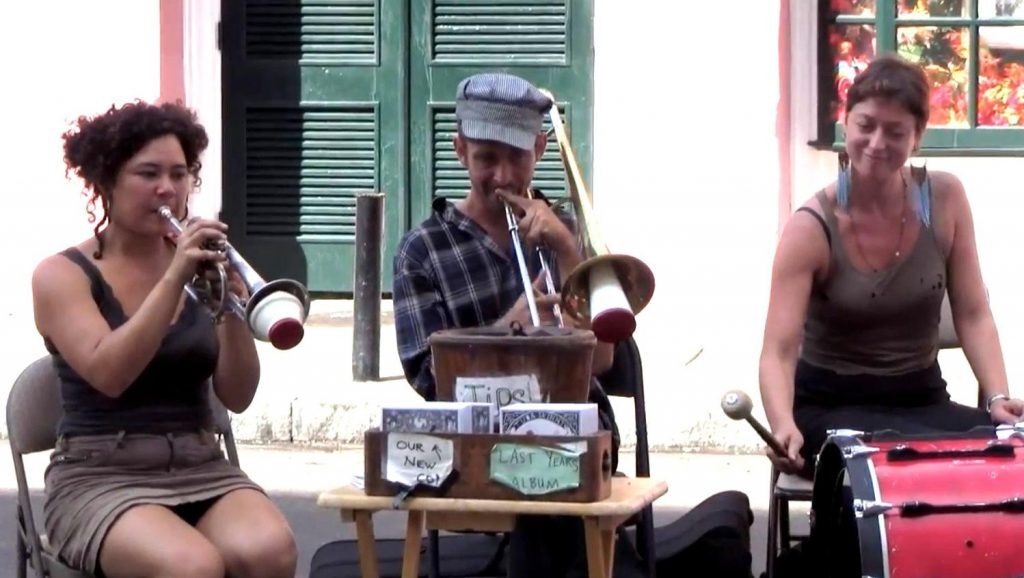
Shaye Cohn, Barnabus Jones, and Erika Lewis of Tuba Skinny pool their musical excellence on the streets of New Orleans. (photo courtesy Pops Coffee via playing-traditional-jazz.blogspot.com)
Other articles and reviews about Tuba Skinny or its members.

Tuba Skinny • Hot Town
I’m enough of a hipster to wish I could dislike Tuba Skinny. To wish I could say they were overrated and their fame undeserved. To
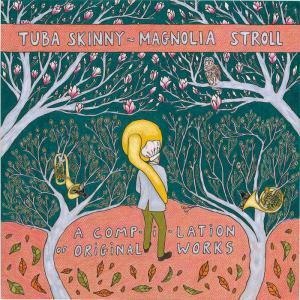
Magnolia Stroll • A Compilation Of Original Works by Tuba Skinny
Since its inception in 2009, as a jazz band (formerly known as the “Dead Man Street Orchestra” playing old time string mountain music) busking on

Maria Muldaur with Tuba Skinny • Let’s Get Happy Together
The band Tuba Skinny (name inspired, perhaps tongue-in-cheek, by a local musician billed as Tuba Fats) was formed as a loose New Orleans street band

Let’s Get Happy Together: Maria Muldaur teams up with Tuba Skinny on new disc
When an iconic female vocalist steps up to front the world’s spunkiest, funkiest trad-jazz combo, musical fireworks soon ensue. The icon is jug-band veteran Maria
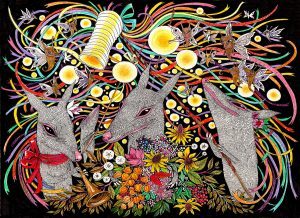
Tuba Skinny • Mardi Gras EP
It’s a strange year in New Orleans. The last time Mardi Gras was officially cancelled was 1979. That year the police union was on strike
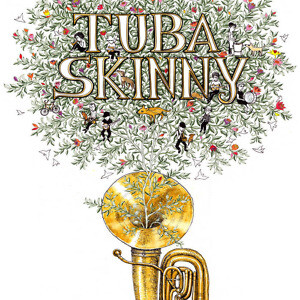
Another take on Tuba Skinny’s Quarantine Album
It is immediately obvious why Tuba Skinny has been invited to the Newport Jazz Festival. (August 22nd. … and if not this year, we pray

Tuba Skinny’s Quarantine Album: Unreleased B-Sides
Tuba Skinny has released about an album a year over their now eleven year history. They were scheduled to record number eleven this April until
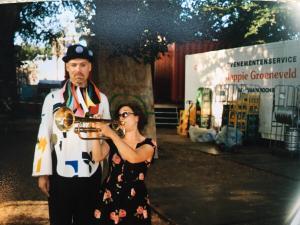
Robin Rapuzzi on Tuba Skinny’s Summer with a Dutch Circus
During the summer of 2018 Tuba Skinny had the unique opportunity to perform as part of the Ashton Brothers circus in the Netherlands. We performed
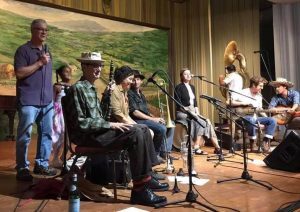
Bringing Tuba Skinny to Philadelphia
We knew Tuba Skinny had a following but we weren’t prepared for a standing room only crowd! I never saw so many joyous, boppin’ people

Frog and Henry 2019ii
A new release from Frog and Henry feels as real and exciting to me as taking home a fresh pile of 78s. Started as a

Jazz Jubilee by the Sea 2019 Recap
The 2019 Jazz Jubilee by the Sea was a real blow-out. World-renowned New Orleans busking-band Tuba Skinny made their first-ever West Coast festival appearance. In

The Hokum High Rollers: Maiden Melodies
I’m breaking some of my own rules in sharing this album with you. For one I’ve no certainty that this band will be around for
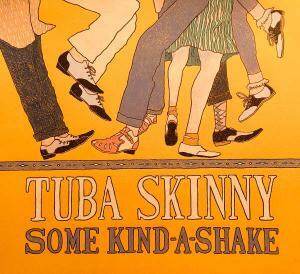
Pops Coffee on Tuba Skinny’s New Album Some Kind-a-Shake
Tuba Skinny’s latest CD entitled Some Kind-a-Shake, contains 14 tracks and is remarkable for four reasons. First, it was recorded at The Living Room Studio
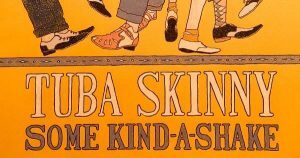
Tuba Skinny’s new album Some Kind-a-Shake
Writing about a new Tuba Skinny album presents a “Rolling Stones” problem. Everyone already knows about the band so there is nothing left to do
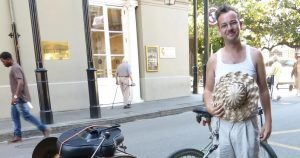
Robin Rapuzzi Discography
Robin Rapuzzi is best known for his work with Tuba Skinny, and Tuba Skinny is most known for Youtube videos, but the band has released

Dr. Michael White Tricentennial Rag
Veteran New Orleans clarinetist Dr. Michael White has exclusively performed traditional jazz throughout his career. Early on he was a member of Danny Barker’s Fairview
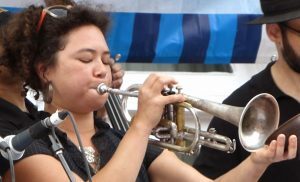
Shaye Cohn Discography
Shaye Cohn is best known for her work with Tuba Skinny, and Tuba Skinny is known for YouTube videos, but the band has released eleven
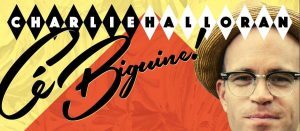
Ce Biguine! by Charlie Halloran
Ce Biguine! by Charlie Halloran When I’m preparing for a review I often write the artist for a comment. If I’m lucky I get a

Wit’s End Brass Band
Everyone knows all the cool kids are in band, but if you needed proof this album is it. 24 or more active musicians from New

How Tuba Skinny’s New Orleans Street Jazz Found Fans Worldwide
I was introduced to Tuba Skinny in 2010 through videos uploaded by YouTube pioneers Al and Judy Alexander. The Alexanders, whose YouTube channel is digitalalexa,

Frog and Henry- Two Self Titled Albums
Frog and Henry consider themselves a New Orleans based band, and they have fine reasons to do so. As a collective, they’ve included members from Tuba
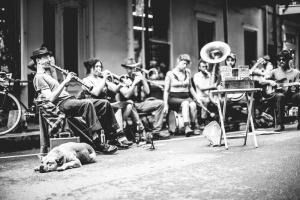
Tuba Skinny, Stars of the New Orleans Renaissance: Three Albums Reviewed
An intriguing question in social history is why creative explosions happen when and where they do. What was it about Switzerland during the Great War
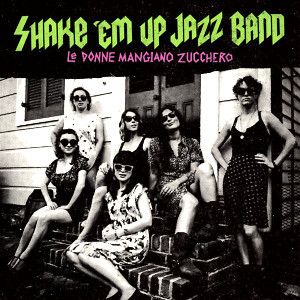
Shake ’Em Up Jazz Band: le Donne Mangiano Zucchero & A Woman’s Place
I recently read a column Tex Wyndham wrote for our predecessor paper The West Coast Rag back in 1990 lamenting the lack of female instrumentalists
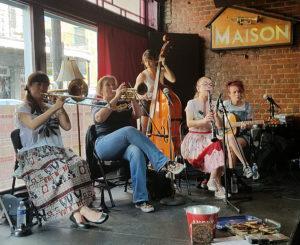
Report From Jazz Fest
It is often said that “getting there is half the fun,” but when it comes to the annual New Orleans Jazz and Heritage Festival, I’ll
Pops Coffee, who lives in Nottingham, England, is an octogenarian who got into traditional jazz late in life with much to discover, learn, and pass on. He wrote an excellent blog, Pops Coffee’s Traditional Jazz, from 2013 through 2018. He has also published three jazz related books including one on Shaye Cohn and Tuba Skinny.





















